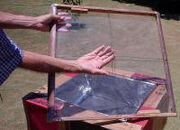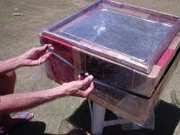
|
| Brazilian garbage scavengers make their own solar cookers from scavenged materials using plans they found in the Solar Cooking Archive |
Events
News and Recent Developments
- November 2009: Forno solar ganha mercado e se volta para exportações - Lusa
- August 2009: Índios de MS experimentam fogão solar - Povos Indígenas no Brasil
- July 2009: Jose Albano reports that a government-sponsored solar box cooker workshop conducted by Paulo Araujo was featured on a Globo TV national news broadcast.
- November 2008: Report on large project in Brazilia - Solar Cooking Plus
- June 2007: Video interview with Celestino Ruivo in São Paulo showing his solar cookers - TV Cultura
- March 2007: José Guimarães writes to describe his project of introducing solar box cookers in the school system in Aracaju, Brazil. More...
- January 2007: Alexandre Souza reports that he and some friends from São Paulo and Boa Vista have tried the Bernard panel model twice. They are making a short movie and one of the characters is a kind of "green tortured" person. Both experiences took place in public space: a public park and a public square. Both were successful (They cooked wild rice with pumpkin and sliced apples). After 2 hours, they served the food for everyone interested and recorded their opinions. They have also printed the plans from the Solar Cooking Archive and given out booklets to hundreds of visitors in the park (Ibirapuera Park in São Paulo, where the International Biennale of Arts is held). A group of Tibetan monks showed up and said they also use the Bernard model in the mountains of Tibet. When they finish the movie, they would like to send it to festivals and to be shown in ecological meetings.
- November 2006: Garbage to gourmet: Innovative program teaches garbage collectors to make cookers out of trash

Wires are attached in a crosswise fashion

while a rubber tube seals against air loss
- March 2006: Enthusiastic new solar promoter Jose Albano (see Solar Cooking Archive informs, inspires Brazilian promoter, has developed an interesting solar box cooker lid system that creates a double-paned plastic window effect and stops air loss through the lid/cooker joint. Mr. Albano notes that this idea works best in areas near the equator, where the sun is often directly overhead and reflectors are not required. The system can be used with cookers made from various materials, including cardboard and wood. The first step is to build a four-sided lid frame using wooden boards about one-inch thick. Next, tautly attach wires in a crosswise fashion on both sides of the wooden frame, creating a “skeleton” that will serve to separate two layers of plastic sheeting and allow for insulating air space between them. Spread a sheet of transparent plastic across one side of the frame, wrap the ends around to the opposite side of each board, and secure with staples. After food has been placed in the cooker, place the lid on top of the four walls of the cooker with the plastic side down. A larger sheet of transparent plastic is then draped over the lid partway down all four sides of the cooker. This sheet is secured using a rubber tube or similar fastener, preventing air from escaping. [Editor’s note: Solar Cookers International recommends polypropylene, polyester or polycarbonate plastic sheeting.]
- July 2005: Professor Arnaldo Moura Bezerra reports that the small city of Uirauna, in the "backwoods" of the state of Paraiba, boasts its own solar cooker production unit. A priest known as Father Domingues manages production of parabolic cookers based on the SK-14 cookers developed by EG-Solar of Germany. Residents use the cookers daily. Contact Arnaldo Moura Bezerra by e-mail: mourabezerra@uol.com.br
The History of Solar Cooking in Brazil
Brazil is the giant of the continent, as seen below in the assessment of nations for solar cooking usage. However, little solar cooking activity has, to our knowledge, taken place in the country. The only indication of interest comes from an individual, Arnoldo Moura Bezerra, an instructor at the Universidade Federal of the Paraiba, who designed and demonstrated the use of a parabolic solar cooker to be used in campgrounds. (Solar Cooker Review Nov '02).
[Information for this section was taken originally from State of the Art of Solar Cooking by Dr. Barbara Knudson]
Climate, Culture, and Special Considerations
Solar Cookers International has rated Brazil as the #7 country in the world in terms of solar cooking potential (See: The 25 countries with the most solar cooking potential). The estimated number of people in Brazil with fuel scarcity but ample sun in 2020 is 8,400,000.
In Brazil, huge areas are being transformed into deserts, particularly in Rio Grande do Sul and in the Northeast. By percentages, the state most affected by the desertification is Rio Grande do Norte, with 80.5% of its territory virtually transformed into desert, followed by Pernambuco with 75.2%, Paraiba with 70.3%, Ceara with 59.7%, and Sergipe with 31.3%.
According to (www.folhadomeioambiente.com.br/fma-99dese99.htm), Brazil loses about 300 million dollars annually due to the desertification that takes place principally in the states of the Northeast region and in the north of Minas Gerais. The Brazilian Government’s Annual Report, regarding the major flora of the world, shows that the destruction of the Amazon’s flora continues in a constant rhythm with the growth inspection around the risk areas. The Brazilian Amazon lost 16,926 km2 from the forests between 1998 and 1999 (according to the article www.tree4life.com/desmata3.htm).
But the actions up until that time put into effect by the Department of the Environment contributed to a strong reduction in the areas of the Amazon forest that were cleared, and already saw a fall of 90% in 2009. The reduction of these extensive green areas is responsible for the reduction of rainfall levels, for the increased concentration of carbon dioxide in the atmosphere which ultimately causes the greenhouse effect, even turning soil vulnerable to erosion.
The annual demand of firewood per family would be 3.1 kg x 365 days, which is near 1,131.5Kg or approximately 1.2 tons annually.T his reasoning assumes that the mass use of firewood is for food preparation.
According to the UN database (www.folhadomeioambiente.com.br/fma-99/dess99.htm) “one forth part of the Brazilian territory is threatened by the process of accelerated desertification.” The introduction and use of solar cookers represents a priceless contribution to reducing desertification, soil erosion, and assuring the survival of the people, animals, and natural resources.
See also:
Resources
Blogs
- Forno Solar. Você ainda vai ter o seu - (Jose Albano's blog)
Reports
Articles in the media
- November 2009: Forno solar ganha mercado e se volta para exportações - Lusa
- August 2009: Índios de MS experimentam fogão solar - Povos Indígenas no Brasil
- July 2008: UFRN produz forno solar de baixo custo - Tribuna do Norte
Audio and video
| June 2010: Fogão Solar on TV news |
| December 2008: Forno solar para zona rural |
| July 2008: Forno solar |
| June 2008: Brazilian TV covers "A Solar Cooker Made at Home". |
EmbedVideo received the bad id "ncesNuX7pWs&eurl" for the service "youtube".
|
Feb. 2008: Aprenda A Fazer Um Fogão Solar Por R$ 30 |
- June 2007: Video interview with Celestino Ruivo in São Paulo showing his solar cookers - TV Cultura
Web pages
- Forno Solar: Renovando o Futuro - Renata Gomes
Contacts
The entities listed below are either based in Brazil, or have established solar cooking projects there:
SCI Associates
- Main article: Solar Cookers International Association
NGOs
Manufacturers and vendors
Individuals
Government agencies
Educational institutions
See also
- Category:Acre
- Category:Alagoas
- Category:Amapá
- Category:Amazonas
- Category:Bahia
- Brazil news archive
- Category:Ceará
- Category:Distrito Federal
- Category:Espírito Santo
- Forno Solar P.S. Multiuso 2012
- Category:Goiás
- Category:Maranhão
- Category:Mato Grosso
- Category:Mato Grosso do Sul
- Category:Minas Gerais
- Category:Paraná
- Category:Paraíba
- Category:Pará
- Category:Pernambuco
- Category:Piauí
- Category:Rio Grande do Norte
- Category:Rio Grande do Sul
- Category:Rio de Janeiro
- Category:Rondônia
- Category:Roraima
- Category:Santa Catarina
- Category:Sergipe
- States of Brazil
- Category:São Paulo
- Category:Tocantins
